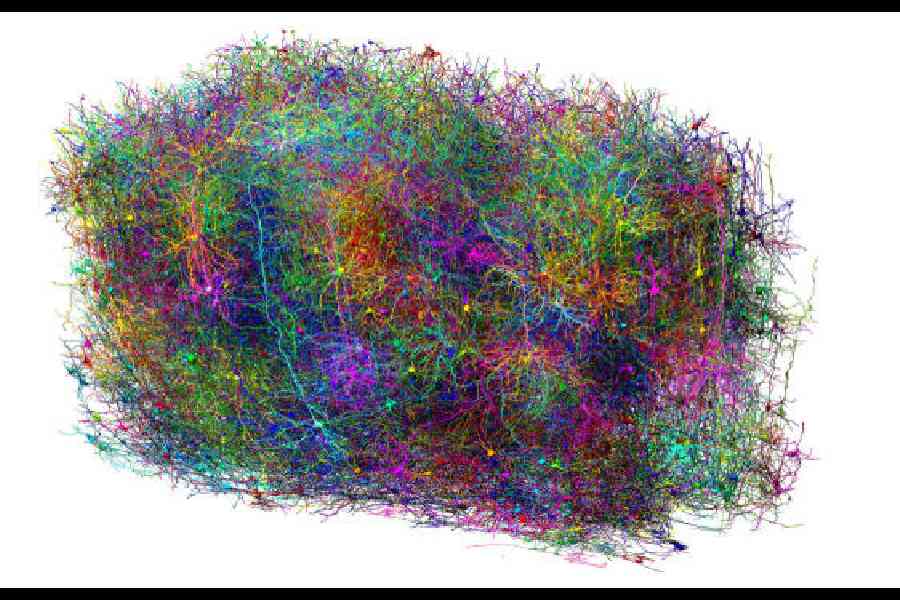The human brain is so complex that scientists have a hard time making sense of it. A piece of neural tissue the size of a grain of sand might be packed with hundreds of thousands of cells linked together by miles of wiring. In 1979, Francis Crick, the Nobel Prize-winning scientist, concluded that the anatomy and activity in just a cubic millimetre of brain matter would forever exceed our understanding.
Forty-six years later, a team of more than 100 scientists has achieved that impossible by recording the cellular activity and mapping the structure in a cubic millimetre of a mouse’s brain — less than 1 per cent of its total volume. In accomplishing this feat, they amassed 1.6 petabytes of data — the equivalent of 22 years of nonstop high-definition video.
“This is a milestone,” said Davi Bock, a neuroscientist at the University of Vermont, US, who was not involved in the study, which was published in Nature. Bock said the advances that made it possible to chart a cubic millimetre of brain boded well for a new goal: mapping the entire brain of a mouse.
More than 130 years have passed since Spanish neuroscientist Santiago Ramón y Cajal first spied individual neurons under a microscope. Later generations worked out how a neuron sends a spike of voltage down a long arm, called an axon. Each axon makes contact with tiny branches, or dendrites, of neighbouring neurons. Some neurons excite their neighbours into firing voltage spikes of their own. Some quiet other neurons.
Human thought somehow emerges from this mix of excitation and inhibition. But how that happens has remained a mystery, largely because scientists have been able to study only a few neurons at a time. In recent decades, technological advances have allowed scientists to start mapping brains in their entirety. In 1986, British researchers published the circuitry of a tiny worm, made up of 302 neurons. In subsequent years, researchers charted bigger brains, such as the 1,40,000 neurons in the brain of a fly.
Could Crick’s impossible dream be possible after all? In 2016, the US government began a $100 million effort to scan a cubic millimetre of a mouse brain. The project was led by scientists at the Allen Institute for Brain Science, Princeton University and Baylor College of Medicine, all in the US.
The researchers zeroed in on a portion of the mouse brain that receives signals from the eyes and reconstructs what the animal sees. In the first stage, the team recorded the activity of neurons in that region as it showed a mouse videos of different landscapes.
The researchers then dissected the mouse brain and doused the cubic millimetre with hardening chemicals. Then they shaved off 28,000 slices from the block of tissue, capturing an image of each one. Computers were trained to recognise the outlines of cells in each slice and link the slices together into three-dimensional shapes. All told, the team charted 2,00,000 neurons along with 523 million neural connections.
To understand how this mesh of neurons functioned, Nuno da Costa — a biologist at the Allen Institute — and his colleagues mapped the activity that had been recorded when the mouse looked at videos. Analysing the data, the researchers discovered patterns in the wiring of the brain that had escaped notice until now. They identified distinct kinds of inhibitory neurons, for instance, that link only to certain other types of neurons.
“When you go into studying the brain, it seems kind of hopeless — there are just so many connections and so much complexity,” said Mariela Petkova, a biophysicist at Harvard, US, who was not involved in the study. “Finding wiring rules is a win. The brain is a lot less messy than people thought,” she said.
Sebastian Seung, a neuroscientist at Princeton and a member of the project, noted that mouse brains and human brains are similar enough that researchers might glean clues that could help them find medications to effectively treat psychological disorders without causing harmful side effects.
“Now you put in a drug, and it goes everywhere,” Seung said. “Being able to reach in and manipulate a cell type — that’s precision.”
NYTNS










